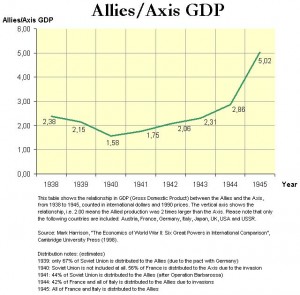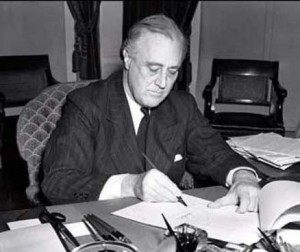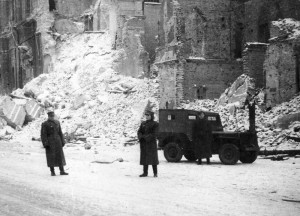 Lend-Lease was a law enacted on March 11, 1941 giving the U.S. government powers to supply the USSR, the UK, Free France, Republic of China, and other allied nations taking part of the World War II with essential war materials. Therefore, between 1941 and 1945, the U.S. government was able to circumvent its neutrality laws by providing materials on the basis that they would be returned after the war. The historical law was signed by President Franklin D. Roosevelt, almost one and a half years after the commencement of the World War II in late 1941. This was roughly about 9 months before the U.S. formally entered the war after the attack on Pearl Harbor.
Lend-Lease was a law enacted on March 11, 1941 giving the U.S. government powers to supply the USSR, the UK, Free France, Republic of China, and other allied nations taking part of the World War II with essential war materials. Therefore, between 1941 and 1945, the U.S. government was able to circumvent its neutrality laws by providing materials on the basis that they would be returned after the war. The historical law was signed by President Franklin D. Roosevelt, almost one and a half years after the commencement of the World War II in late 1941. This was roughly about 9 months before the U.S. formally entered the war after the attack on Pearl Harbor.
The Lend-Lease law empowered the government to channel a sum of $50.1 billion worth of military supplies to the Allied forces. Britain received $31.4, the USSR received $3.4 billion, and China was given $1.6 billion. The remaining $14 billion was allocated to other Allied states taking part in the offensive.
The specific terms of the agreement stated that the equipment was to be utilized until the time for its destruction or the completion of war. Canada enacted a similar law that sent about $4.7 billion to Britain and the Soviet Union. This form of aid was issued free of charge.
Lend-Lease Act
 President Franklin D. Roosevelt appointed Edward R. Stettinius as Undersecretary of State to prepare the administration for Lend-Lease aid. Aid meant for the USSR was managed by Harry Hopkins. The Foreign Economic Administration was charged with managing the execution of the aid and overseeing its management.
President Franklin D. Roosevelt appointed Edward R. Stettinius as Undersecretary of State to prepare the administration for Lend-Lease aid. Aid meant for the USSR was managed by Harry Hopkins. The Foreign Economic Administration was charged with managing the execution of the aid and overseeing its management.
Necessity
Germany had gone to war with its enemy states in Europe. In 1939, Hitler’s men had attacked and occupied Poland, a move which raised tension between Nazi Germany and its Western neighbors who declared war.
In response to the threats of war issued against Germany, Hitler mobilized his troops in preparation for a long period of war against his enemies. He, together with his tacticians, drew up war plans designed to crush the west.
One of his first moves was to take over the Low Countries so as to block enemy attack paths to some key regions in Germany.
Operation Case Yellow
In 1940, during a mission called Operation Fall Gelb, Germany launched surprise attacks on these three countries.
The move by Hitler to occupy these three nations resulted in more tension between his country and the London and Paris governments who assembles their military might in response.
The Germans successfully conquered all of their neighbors, holding some enemy soldiers as prisoners. The ultimate victory of the Germans came when they conquered France in the “Fall of France” and occupied Paris.
U.S. Intervention
The events that ensued after Hitler’s actions were of great concern to the U.S. government and, although it had initially chosen to maintain a neutral stance in the war, the failings of the Allied war effort swayed some towards intervention. To mitigate further effects and to weaken Germany’s control over Europe, the U.S. passed the Lend-Lease law. After Pearl Harbor, the Americans sent soldiers as well as equipment.
Significance
Lend-Lease was a crucial factor in the success against Germany and the eventual conclusion of World War II in 1945. Between 1943 and 1944 about 25% of all UK munitions came through this intervention. Transport aircraft comprised of about 25% of the goods shipped to Britain, followed by food supplies, ships, and land vehicles.
Even after the U.S. forces had recovered most of Europe, Lend-Lease continued. Many of the ships and other supplies that were leant were sold at a 90% discount to the British and other allies.
Lend-Lease can be understood when considering the economic conditions caused by the war. Most nations cut back severely on the manufacturing of non-essential goods, spending the bulk of their time producing military equipment. This lead to shortages of various products required during war.
Aid Extended to the USSR
 The Soviet Union in particular was highly dependent on railway transportation facilities, but the impacts of the war had practically led to the shutdown of this essential piece of infrastructure. By the early 40’s, only about 92 locomotives were manufactured. 11,000 rail cars and 2,000 locomotives were delivered as aid to USSR under Lend-Lease in an attempt to boost their military battle power. Likewise the U.S. government sent some 18,700 aircraft which greatly improved the Soviet’s air force capabilities.
The Soviet Union in particular was highly dependent on railway transportation facilities, but the impacts of the war had practically led to the shutdown of this essential piece of infrastructure. By the early 40’s, only about 92 locomotives were manufactured. 11,000 rail cars and 2,000 locomotives were delivered as aid to USSR under Lend-Lease in an attempt to boost their military battle power. Likewise the U.S. government sent some 18,700 aircraft which greatly improved the Soviet’s air force capabilities.
U.S.-made trucks were also shipped to the Soviets to strengthen their Red Army tank units. By the time World War II ended, almost two thirds of the trucks used by the USSR were U.S. built.
The American government also shipped telecommunication equipment, canned rations, clothing, and aluminum to its allies in an attempt to strengthen their positions.
Public Involvement
Eager to sensitize the public on the importance of this controversial law, President Roosevelt likened the legislature to a man lending his neighbor a garden hose to stop a fire in his home. He explained that when the fire was put out, he did not want the money he paid for the hose, he wanted his hose back. The legislature was widely seen as a positive move to back the United Nations in its quest to foster peace in Europe.
Reverse Lend-Lease
Reverse lend-lease was enacted by countries which had benefited from lend-lease to repay the U.S. for its role during the Second World War. For instance, the U.K. supplied the U.S. military with ambulances and gave extensive material assistance to U.S. soldiers stationed in Europe. New Zealand supplied food to the U.S. forces stationed in the South Pacific.